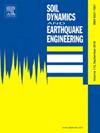Numerical earthquake-induced landslide hazard assessment at regional scale in the Colombian Andes
IF 4.2
2区 工程技术
Q1 ENGINEERING, GEOLOGICAL
引用次数: 0
Abstract
This paper presents an implementation of the SEM-Newmark analysis framework as a method for the earthquake-induced landslide hazard assessment at a regional scale. The implementation relies on a semi-coupling between () the physics-based numerical simulation of seismic wave propagation in the 3D domain through the Spectral Element Method (SEM) and () the evaluation of seismic permanent displacements in spatial domains through the direct Newmark Method. The numerical solver was verified against analytical solutions and validated on the case study of the Mesetas earthquake in the Colombian Andes, where hundreds of landslides were triggered. Results highlight the significance of incorporating topographic effects and demonstrate that the proposed framework provides a more accurate hazard assessment compared to traditional pseudo-static approaches. A basic probabilistic hazard zonation approach is introduced, linking landslide occurrence to permanent displacement thresholds, resembling the concept of a fragility curve. The SEM-Newmark analysis framework offers a robust alternative for seismic hazard evaluation in regions with complex topography, improving decision-making for earthquake-prone areas.
哥伦比亚安第斯山脉区域尺度地震诱发滑坡危险性数值评价
本文提出了一种基于SEM-Newmark分析框架的区域地震滑坡危险性评价方法。该方法的实现依赖于以下两种方法之间的半耦合:(1)通过谱元法(SEM)对地震波在三维域中的传播进行基于物理的数值模拟;(2)通过直接Newmark方法对空间域中的地震永久位移进行评估。数值解与解析解进行了验证,并以哥伦比亚安第斯山脉Mw6.0 Mesetas地震为例进行了验证,该地震引发了数百次滑坡。结果强调了纳入地形效应的重要性,并表明与传统的伪静态方法相比,所提出的框架提供了更准确的危害评估。介绍了一种基本的概率灾害区划方法,将滑坡发生与永久位移阈值联系起来,类似于脆弱性曲线的概念。SEM-Newmark分析框架为复杂地形地区的地震危险性评估提供了一个强大的替代方案,改善了地震易发地区的决策。
本文章由计算机程序翻译,如有差异,请以英文原文为准。
求助全文
约1分钟内获得全文
求助全文
来源期刊

Soil Dynamics and Earthquake Engineering
工程技术-地球科学综合
CiteScore
7.50
自引率
15.00%
发文量
446
审稿时长
8 months
期刊介绍:
The journal aims to encourage and enhance the role of mechanics and other disciplines as they relate to earthquake engineering by providing opportunities for the publication of the work of applied mathematicians, engineers and other applied scientists involved in solving problems closely related to the field of earthquake engineering and geotechnical earthquake engineering.
Emphasis is placed on new concepts and techniques, but case histories will also be published if they enhance the presentation and understanding of new technical concepts.
 求助内容:
求助内容: 应助结果提醒方式:
应助结果提醒方式:


